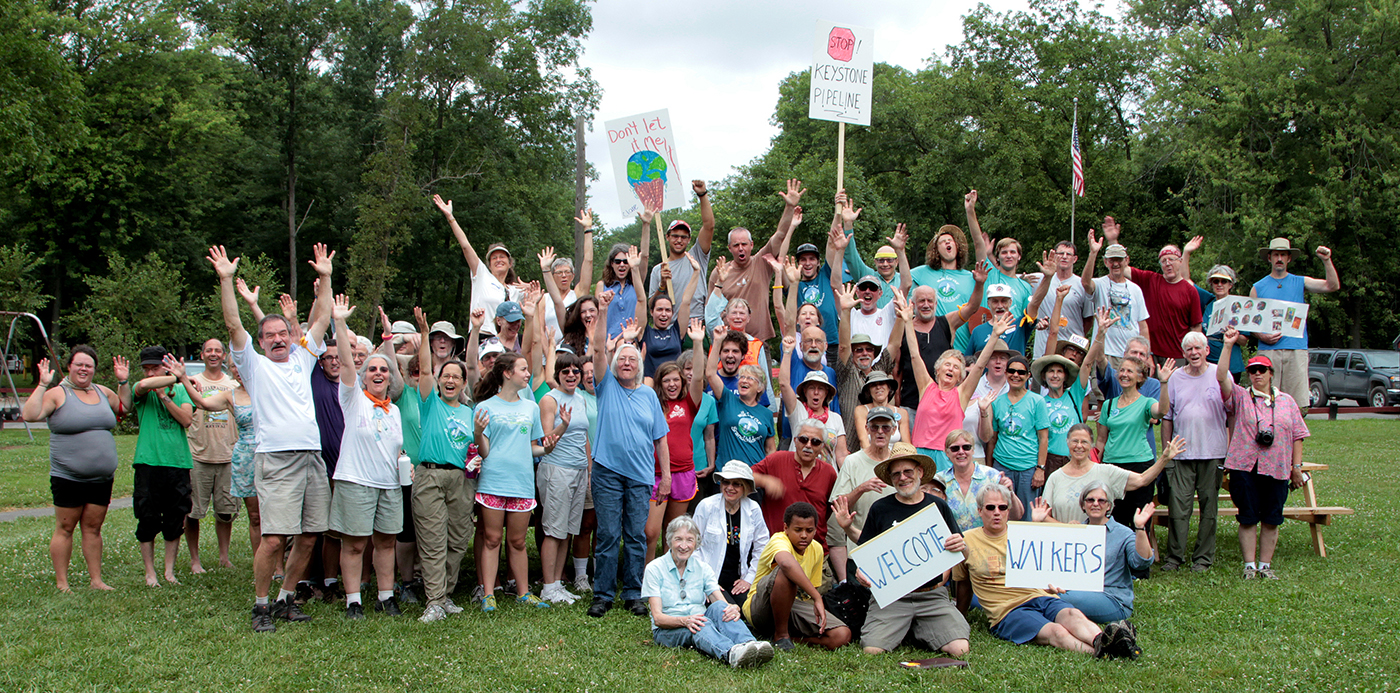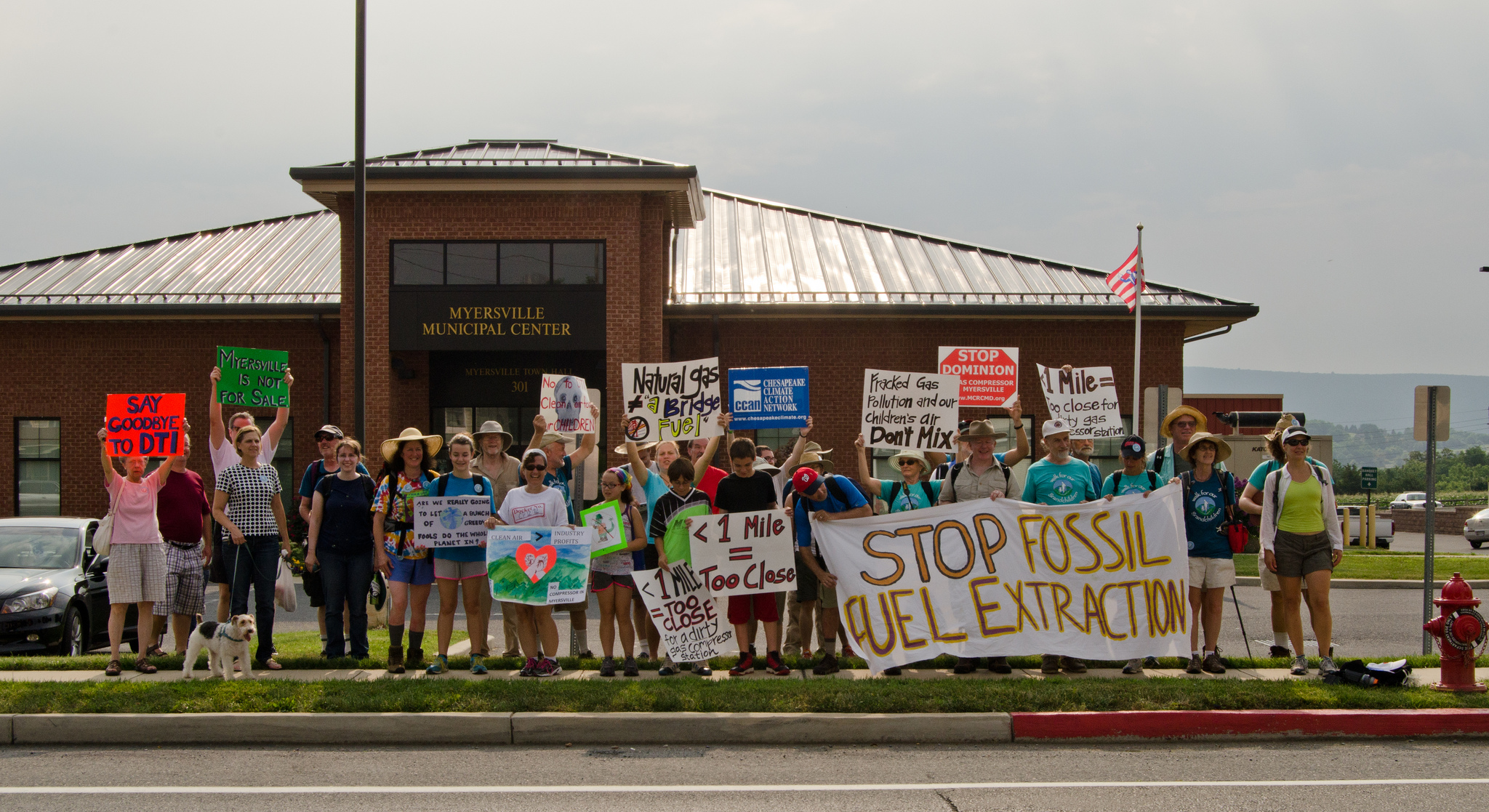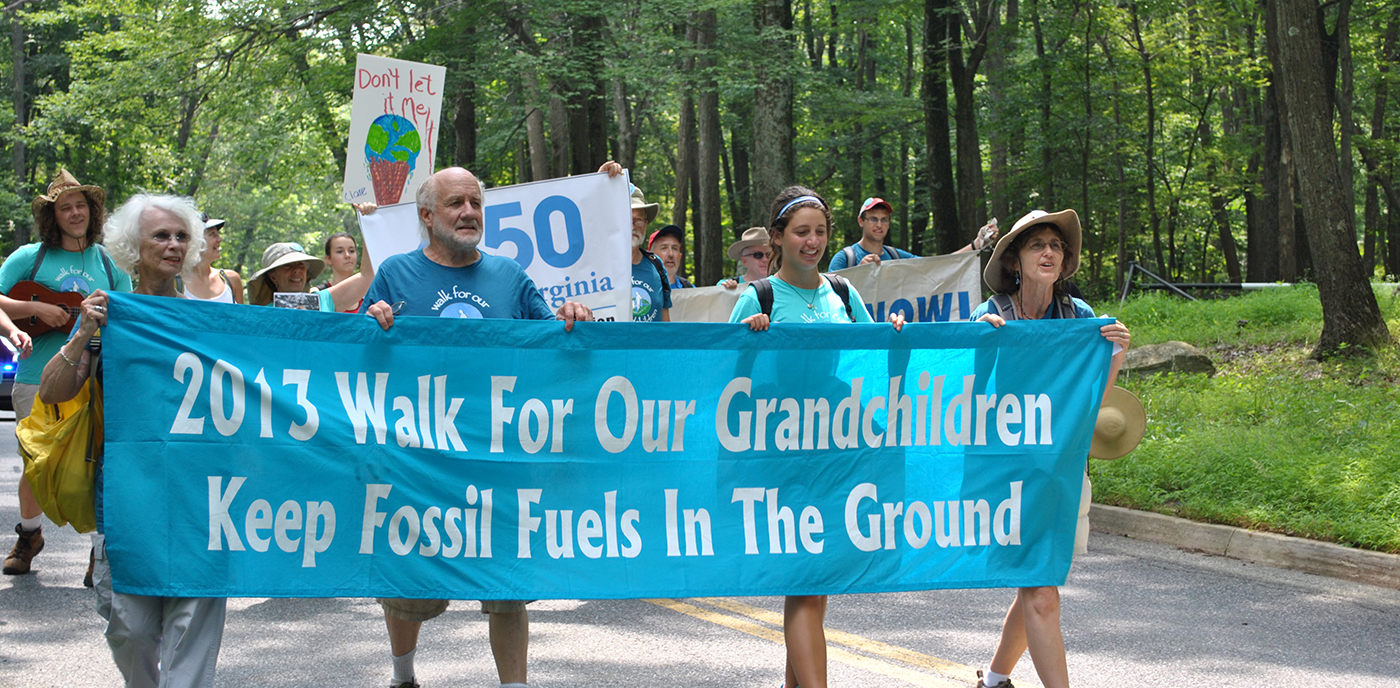The following is a Day 3 update by Greg Yost, who’s on the trail of the Walk for Our Grandchildren, July 19th-July 27th.
Reinforcements arrive.
After spending the last two days walking down roads and through valleys where Confederate and Union troops maneuvered 150 years ago, it feels only natural to think of the huge influx of new walkers this evening as fresh troops arriving just in time for our offensive to recapture the future from fossil fuels. Our forces have more than tripled since Friday at Camp David.
We’re in Harpers Ferry, WV, itself a place pregnant with Civil War history and meaning. Steve Norris, one the Walk’s originators, made those connections for us as we gathered for orientation in a beautiful field now dotted with our tents on a bluff overlooking the Potomac River.
Continue reading
#Walk4Grandkids Day 2: Standing with Myersville
The following is a Day 2 update by Greg Yost, who’s on the trail of the Walk for Our Grandchildren, July 19th-July 27th.
“I say, ‘Shut up, legs!'”—German cycling hard man Jens Voigt on his secret to his success.
Toes, feet, calves, knees. We received quite an education today in the lower anatomy and its surprising potential for creating human misery. But the 2013 Walk For Our Grandchildren is never intimidated. We say, “Shut up, legs!” and on we go!
Our first stop today was Myersville, MD, the site of a proposed gas compressor station on the edge of town.
This is an interesting story. What happens when a corporation runs headlong into a town with an activated citizenry that just doesn’t roll over for them? Dominion Transmission, Inc.(DTI), a subsidiary of Dominion Resources, wants to site a key piece of fracking infrastructure in Myersville as one link in a chain allowing them to move fracked gas from the Marcellus Shale to an eventual export terminal at Cove Point, MD. And this is a pretty good idea, too. Or at least it is if you’re DTI.
Continue reading
#Walk4Grandkids Day 1: Heat! Blisters! Sweat and sore muscles!
The following is a Day 1 update by Greg Yost, who’s on the trail of the Walk for Our Grandchildren, July 19th-July 27th.
Heat! Blisters! Sweat and sore muscles!
Exhaustion? Yeah, there was some of that, too…Man, what a fantastic first day we had.
The 2013 Walk For Our Grandchildren got off to a roaring start today from Camp David and tonight is 11 miles closer to its White House goal.
We’re walking 100 miles to carry a message from every dried up, burned, flooded, hurricaned, and sick-and-tired-of-climate-inaction corner of this country to President Obama. We demand substantive leadership climate NOW starting with a final and unequivocal rejection of the Keystone XL pipeline.
Basically, President Obama, no more ifs, ands, or buts. Climate change is the most pressing issue this nation has ever faced. Lead or get out of the way.
And who is delivering this feisty message? WE ARE! Today we were 22 strong with critical back up from our support team keeping us supplied with snacks and cool water. We’ll be in Harpers Ferry, WV on Sunday where our numbers will grow to 75 or more. As we move closer to DC, numbers will swell yet again with hundreds joining each day as day walkers.
Interested? Go to http://joinsummerheat.org/maryland and sign up to get more information on where and when to meet us. Also, check out http://joinsummerheat.org/dc for the latest on two actions we’re initiating in DC on Friday, July 26th and Saturday, July 27th. Get to DC if you can and get active. This is a great way to do it.
Continue reading
Why I’m Walking From Camp David to DC
This is one in a series of posts sharing the stories of grandparents, parents and young people who are joining the Walk for Our Grandchildren, July 19th-27th.
 This week-long, 100-mile walk will bring an intergenerational message of hope from Camp David to the White House to demand that President Obama reject the Keystone XL tar sands oil pipeline and confront the growing crisis of climate change. You can join us for a day on the trail, or join walkers and thousands of others for a culminating rally at the White House on July 27th. Click here to learn more and sign up.
This week-long, 100-mile walk will bring an intergenerational message of hope from Camp David to the White House to demand that President Obama reject the Keystone XL tar sands oil pipeline and confront the growing crisis of climate change. You can join us for a day on the trail, or join walkers and thousands of others for a culminating rally at the White House on July 27th. Click here to learn more and sign up.
 I’m making the 100-mile “Walk for Our Grandchildren” trip from Camp David to the White House because nothing in my 51 years has made me happier than having a son.
I’m making the 100-mile “Walk for Our Grandchildren” trip from Camp David to the White House because nothing in my 51 years has made me happier than having a son.
Sasha Tidwell is 16 years old now. He is an honor student, an Eagle Scout, and a starting pitcher for his varsity baseball team. Before Sasha was born, I thought I knew what happiness was. I had climbed peaks in the Alps, written three books, and shaken hands with the Dalai Lama. Life was pretty full. Then Sasha was born. It was May 30th, 1997.
At that moment I was lifted onto a cloud of joy – far above the old world below – and I have never come back down. I watched him take his first step, read his first book (Berenstain Bears), ride his first skateboard, and – last week – drive his first car. Through all the skinned knees and book reports and muddy shoes on the carpet, I have always known that being with him and being his father made me the happiest person I could ever be. Life was pretty much perfect.
Except for the sadness. Every day, mixed deeply into the joy, is a sadness: Our climate is changing. The seas are rising. Storms are getting bigger.
Continue reading
Toward Our Own Tipping Point: Why I'm Walking for Our Grandchildren
This is one in a series of posts sharing the stories of grandparents, parents and young people who are joining the Walk for Our Grandchildren, July 19th-27th.

This week-long, 100-mile walk will bring an intergenerational message of hope from Camp David to the White House to demand that President Obama reject the Keystone XL tar sands oil pipeline and confront the growing crisis of climate change. You can join us for a day on the trail, or join walkers and thousands of others for a culminating rally at the White House on July 27th. Click here to learn more and sign up.
By Elisabeth Hoffman, Clarksville, Maryland
 My parents married in November 1945, just months after the end of World War II. My father had worked in the Navy developing radar; my mother used coupons to buy rationed food and fabric, gasoline and tires. At the war’s end, after their work and sacrifice, they decided it was safe to get married. As much as was possible, they could count on a future for themselves and their children.
My parents married in November 1945, just months after the end of World War II. My father had worked in the Navy developing radar; my mother used coupons to buy rationed food and fabric, gasoline and tires. At the war’s end, after their work and sacrifice, they decided it was safe to get married. As much as was possible, they could count on a future for themselves and their children.
My children were born in 1984 and 1994. I can’t know what their future holds, but my actions now — while we still have time to avert the worst climate changes — will shape their world.
This is our time to do whatever we can to ensure a future for our children, our grandchildren and generations to come. Even if that requires a WWII-like effort.
Continue reading
Building A Hand: Why I'm Walking for Our Grandchildren
This is one in a series of posts sharing the stories of grandparents, parents and young people who are joining the Walk for Our Grandchildren, July 19th-27th.
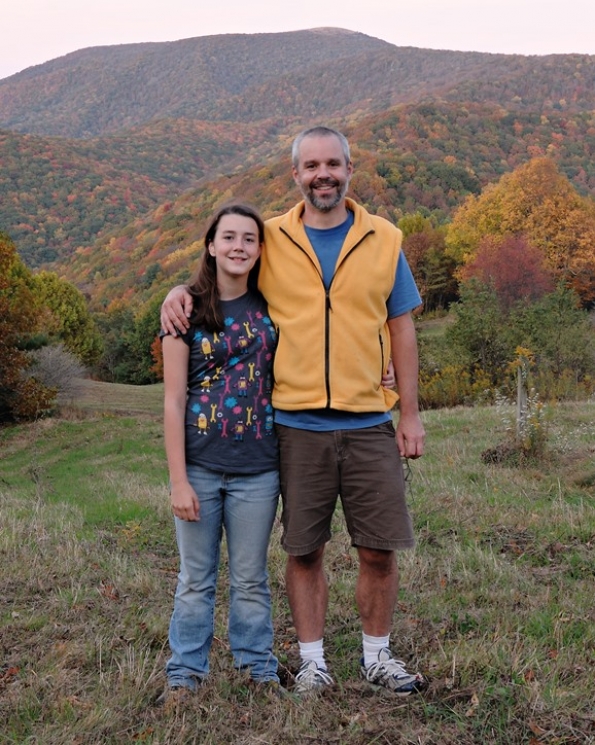 This week-long, 100-mile walk will bring an intergenerational message of hope from Camp David to the White House to demand that President Obama reject the Keystone XL tar sands oil pipeline and confront the growing crisis of climate change. You can join us for a day on the trail, or join walkers and thousands of others for a culminating rally at the White House on July 27th. Click here to learn more and sign up.
This week-long, 100-mile walk will bring an intergenerational message of hope from Camp David to the White House to demand that President Obama reject the Keystone XL tar sands oil pipeline and confront the growing crisis of climate change. You can join us for a day on the trail, or join walkers and thousands of others for a culminating rally at the White House on July 27th. Click here to learn more and sign up.
By Greg Yost
 I admit it’s a bit odd. Climate change is daunting—rising temperatures, extreme weather, powerful political and economic forces which work against finding solutions—and I’m proposing to do something about this by taking a walk? It wouldn’t surprise me to have someone point and laugh, but there’s more going on with this Walk For Our Grandchildren than meets the eye.
I admit it’s a bit odd. Climate change is daunting—rising temperatures, extreme weather, powerful political and economic forces which work against finding solutions—and I’m proposing to do something about this by taking a walk? It wouldn’t surprise me to have someone point and laugh, but there’s more going on with this Walk For Our Grandchildren than meets the eye.
I used to be isolated. I’d sit in front of a computer screen and read scientists’ predictions about the consequences of carbon pollution and I’d feel so low, not just because the predictions were depressing, but also because it seemed no one was paying attention. It was difficult to talk about, to be that guy who brought it up to friends and family, at work or at church. Good, otherwise emotionally healthy people have filters in place to screen the stuff that is depressing or scary, and especially if they feel like there’s nothing they can do about it, anyway. For a long time, climate change was simply getting caught in the filters.
But that’s been changing. At some point in the last few years I feel like the tiny little trickle of awareness I had about the enormity of the climate challenge became one tributary to a gathering river of people. These folks aren’t just worrying or wringing their hands, either. Like any good river, they’re moving. We’re taking action. I’ve even learned how to do it myself and it’s actually not so hard. You just empty your hands, setting aside a few parts of your life for a moment to ready yourself for work that needs doing. Then you think about what you love and want to protect, you roll up your sleeves, and you wade in.
Continue reading
Fighting Water Pollution in Curtis Bay
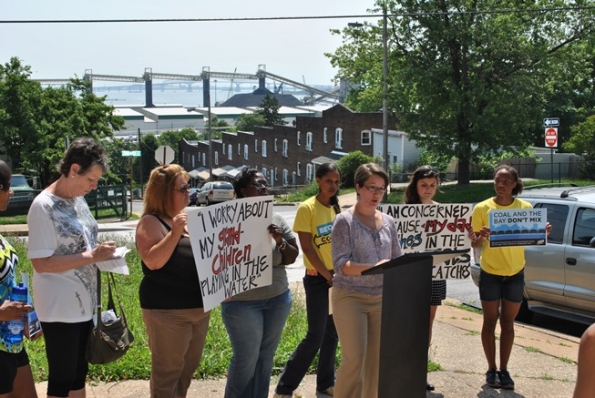
On Wednesday we were out in Curtis Bay, Maryland, home to the CSX Coal Facility. CSX is a coal export facility whose huge coal piles are visible when you’re standing on a hill in the neighborhood.
This isn’t the first time we’ve been out there. Four other CCAN fellows and I have been out in Curtis Bay multiple times the past few weeks: knocking on doors and talking to local residents about the effects coal pollution has on their day-to-day lives. We’ve heard stories from coal dust coating peoples’ homes and pools, to worries about fishing in local waters, to concerns about kids playing outside.
These issues became critically important leading up to today, because CSX is up for a new water pollution permit – one that needs to be a lot stronger. For example, the current permit doesn’t limit levels of heavy metals that can be dumped right into the harbor.
Continue reading
Md. State Agency Puts 'Cart Before Horse' on Fracking
Without first measuring risks to people and land, state proposes inadequate ‘best practices’ guidelines for drilling
BALTIMORE—Despite explicit concerns from landowners and environmentalists, the Maryland Department of the Environment (MDE) yesterday issued a “best practices” draft report for companies that want to drill for fracked natural gas in Maryland. The agency released the report before formally assessing and inventorying the actual risks of the controversial drilling method itself. The failure to assess the likely impacts of fracking on human and natural communities—as a first step—renders the “best practices” report premature and deeply problematic, according to Maryland civic and environmental leaders.
“The cart has been put before the horse on fracking in Maryland,” said Mike Tidwell, director of the Chesapeake Climate Action Network. “What sense does it make to lay out guidelines for the ‘best way’ to frack for natural gas when the state hasn’t formally inventoried the risks and harm that could come the moment drill bits enter our soil?”
June 2013 Maryland
|
|
June 2013 | Issue #65 FROM DIRECTOR MIKE TIDWELL
When CCAN was founded in 2002, the level of carbon dioxide in the atmosphere was 373 parts per million. Now, despite a growing clean-energy movement worldwide, scientists reported last month that the carbon level had reached a whole new stage of danger: 400 parts per million. There hasn’t been this much heat-trapping CO2 in the Earth’s atmosphere in at least 3 million years. The result has been a marked increase in extreme and destructive weather. Listen to my NPR radio commentary concerning DC’s decision to spend $1 billion to put more power lines underground due to bigger storms. Imagine a world where we trap heat in the atmosphere equal to the energy of 400,000 Hiroshima bombs exploding every day. That’s what we are doing right now. So despite the best efforts of CCAN and groups like us worldwide, we have much more work to do to fight dirty energy and promote clean power… Tell Governor O’Malley: Keep your promise to get the facts on fracking! Want the full update on how Maryland state agencies are carrying out the Governor’s order? Check out Megan’s blog post. Dirty coal’s new scheme to keep afloat and keep polluting We’re fighting back by challenging the export companies as they apply for pollution permits needed to expand their operations. We have our first opportunity to take action in Baltimore: Submit a public comment urging the Maryland Department of the Environment to strengthen water pollution controls at the CSX coal export piers on Baltimore’s Harbor. Camp David to DC: See you on the trail to stop Keystone XL? DC needs wind and solar power not black liquor! Dominion’s new solar program — Is it for you? Chasing Ice Coming to Virginia Greet VP Biden with a big “No Keystone XL!” message Success! Climate wake-up call reaches Dominion shareholders Ready…set…register for Power Shift 2013!
Meet Maryland community activist Ann Marie Nau Ann is a resident of Myersville, a small community in Maryland fighting a huge natural gas compressor station that Dominion Transmission wants to build in the heart of their t Your age: 46 Where you live: Myersville, MD Your profession: Self-employed (transcriber) and stay-at-home Mom Why are you a CCAN volunteer? I became aware of CCAN while researching organizations to help with our local fight against Dominion Transmission’s proposal to build a16,000 natural gas compressor station within the town limits of our rural community and have been inspired by CCAN’s mission, hard work and the dedication of their wonderful staff. What has inspired you most working with CCAN? CCAN staff and volunteers are tireless! I have seen them in Western Maryland fighting fracking, in Annapolis working on various environmental and energy bills, in Frederick fighting the incinerator and compressor stations, in Baltimore hosting conferences, and throughout the state working on climate issues. They have marched on D.C. and are active in Virginia. Being a member of Myersville Citizens for a Rural Community and seeing first hand how hard it can be to build coalitions, I have always been impressed with CCAN’s willingness to work with other environmental groups. What are the impacts of climate change and/or the fossil fuel industry that hit closest to home for you? As unconventional drilling expands, the infrastructure needed to support it also increases. My beautiful rural community nestled in the scenic Middletown Valley is being bull dozed by big business and the federal government via the Federal Energy Regulatory Commission (FERC) to place a huge natural gas compressor station in our town and within one mile of our elementary school. Despite the Town Council denying zoning approval, Dominion has been granted approval to proceed by FERC. If fracking proceeds in Western Maryland and if Dominion is granted the authority to export natural gas via the Cove Point facility, I am afraid Maryland will be faced with the same infrastructure development seen in Pennsylvania, which has turned much of the rural landscape into industrialized areas, polluting the land, water and air. What do you hope to see happen to address climate change in the next year? On a local level, I am very concerned about the proposed Frederick incinerator and the prospect of fracking in Western Maryland as well as the proposed Cove Point Export Project. What do you like to do when you’re not working on climate change? I enjoy bird watching, or nature watching in general. I’m a bit of a jack-of-all-trades (and master of none) so whatever project I currently have going, whether it be cupcake decorating for a party, sewing curtains, or working in my (mostly) native flower garden. I adore spending time with my nieces and nephews! Who would you high five? I would most like to high five those people on the front lines who are negatively impacted by the coal and gas industry and who continue to fight, who continue to “speak truth to power,” and who refuse to be intimidated. It is their struggles that motivate me and remind me that I can no longer be silent. |
–MARYLAND– Water Pollution Permit Citizen Comment Delivery An Explosion of Fracking and the TPP Triple Divide Screening –DC– Tell the EPA: Protect Our Water from Power Plant Pollution Walk for Our Grandchildren Walk for Our Grandchildren: White House rally –VIRGINIA– Loudoun: Wake up to climate change Rally to tell VP Biden: No KXL!
|
Gov. O'Malley's Fracking Commission Falling Short
In 2012, the Maryland General Assembly failed to pass a common-sense fracking moratorium that would give Marylanders the protections we need from this dangerous and risky gas drilling practice.
Until our elected officials get to work to protect us, our safety is in the hands of state agencies, which have only a year and some pocket change remaining to complete the long list of scientific risk studies called for in Governor O’Malley’s 2011 Executive Order on fracking. That order laid out a process for determining if fracking would pose unacceptable risks to Marylanders and established a 15-person advisory commission to oversee the review in conjuction with state agencies.
I’ve put together a timeline of how Governor O’Malley’s executive order has been carried out to date. Given the stakes — that this executive order is currently all that stands between Maryland communities and dangerous fracking — you’ll see that the process is falling far short.
Without any funding and a severe lack of resources, the commission is already a year behind. And they only have until August of 2014 to complete studies on as many as 16 different impact areas.

